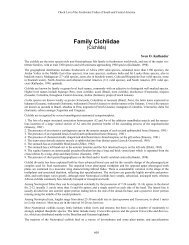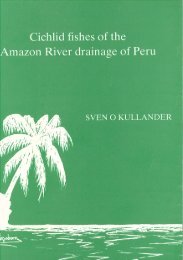Open Access PDF - Sven Kullander
Open Access PDF - Sven Kullander
Open Access PDF - Sven Kullander
You also want an ePaper? Increase the reach of your titles
YUMPU automatically turns print PDFs into web optimized ePapers that Google loves.
ocellated blotch. Bar 2 represented by small black<br />
spot (usually ocellated) above upper lateral line<br />
and wide black, white-margined bar from upper<br />
lateral line down to level of lower margin of<br />
pectoral fin base. Bar 3 represented by small dark<br />
spot (usually ocellated) above level of upper<br />
lateral line and a black bar or blotch below it,<br />
commonly ocellated. White margins bordering<br />
black markings may consist of aggregates of white<br />
spots or complete white borders. Light spots on<br />
side and head characteristic of smaller specimens<br />
absent or very indistinct.<br />
Spinous dorsal fin blackish, soft dorsal fin<br />
brown with few light spots posteriorly or immaculate.<br />
Anal fin brownish. Caudal fin brown,<br />
usually without pattern of light spots. Caudal<br />
ocellus above level of lower lateral line, ringed<br />
with silver. Pelvic fin brownish grey.<br />
Two large females, 290-310 mm SL, have both<br />
pattern of white spots and ocellated bars; bars<br />
more prominent dorsally. One male, 325 mm SL,<br />
shows intermediate pattern with both bars and<br />
white spotting.<br />
Live colouration. No information available.<br />
Geographical distribution. Cichla vazzoleri is<br />
recorded from the middle Rio Uatumã and<br />
lower Rio Trombetas including but not above the<br />
Cachoeira Porteira, to the Oriximiná region at the<br />
mouth of the Rio Cuminá (Fig. 75).<br />
Etymology. Named in honour of Gelso Vazzoler<br />
(1929-1987), collector of part of the type series,<br />
former head of the Departamento de Biologia<br />
Acuática, INPA, Manaus.<br />
Notes. Cichla vazzoleri is most similar to C. pinima.<br />
Refer to comparison under that species.<br />
Jégu et al. (1989) described Mylesinus paraschomburgkii,<br />
a rheophilic characid from the Rio<br />
Trombetas (Cachoeira Vira-Mundo and upstream)<br />
and Rio Uatumã (Cachoeira do Miriti and upstream).<br />
This species appears to be restricted to<br />
rapids, and thus presents different dispersal options<br />
than the Cichla species. Although the distribution<br />
pattern of M. paraschomburgkii is similar<br />
to that of C. vazzoleri, which is present in both the<br />
Uatumã and the Trombetas, C. vazzoleri, although<br />
collected from rapids in both rivers, is present in<br />
the lower Rio Trombetas chiefly in lowland conditions.<br />
We are unaware of other fish species<br />
restricted to the Uatumã and lower Trombetas<br />
Ichthyol. Explor. Freshwaters, Vol. 17, No. 4<br />
373<br />
rivers, but we also cannot conclude that this is<br />
the total distribution of C. vazzoleri.<br />
There is no significant difference in proportional<br />
measurements or meristics between Trombetas<br />
and Uatumã samples. There is no clear<br />
modality in the counts of soft dorsal and pectoral<br />
fin ray counts of the species. This is also the case<br />
within populations for the pectoral fin count<br />
(Trombetas 14 (7), 15 (7), Uatumã 14 (7), 15 (6)),<br />
whereas the Uatumã sample has a clear mode in<br />
soft dorsal fin rays, and the mode of combined<br />
spines and rays is different (Trombetas XIV.17 (1),<br />
XV.16 (5), XV.17 (9), XVI.16 (5), Uatumã XV.15 (2),<br />
XV.16 (8), XV.17 (3)). The distribution of E1 scales<br />
is similar in the two geographical samples (ranges:<br />
Trombetas 97-114, Uatumã 95-108).<br />
Cichla temensis Humboldt, 1821<br />
(Figs. 81-89)<br />
Cichla temensis Humboldt, in Humboldt & Valenciennes,<br />
1821: 169 (Temi).<br />
Cichla atabapensis Humboldt, in Humboldt &<br />
Valenciennes, 1821: 168 (l’Orénoque; Rio Atabapo).<br />
Cichla Tucunare Heckel, 1840: 409 (Rio-branco).<br />
Cychla flavo-maculata Jardine, 1843: 145, pl. 6 (Rio<br />
Negro and Padauiri).<br />
Cychla trifasciata Jardine, 1843: 151, pl. 9 (Rio<br />
Negro; Padauiri).<br />
Cichla unitaeniatus Magalhães, 1931: 225 (Rio<br />
Negro e do Purus).<br />
Material examined. 73 specimens, 25.6-375 mm SL.<br />
Guyana: Ireng River drainage: BMNH 1968.9.26:1, 1,<br />
218 mm SL; Pirara Stop-Off; 30 Sep 1957, R. H. Lowe-<br />
McConnell. Colombia: Rio Orinoco drainage: ICN-<br />
MHN uncat., 2; Vichada: Rio Elvita, Puerto Carreño;<br />
May 1974, P. Cala. Venezuela: Rio Negro drainage:<br />
USNM 269330, 1, 112.5 mm SL; Amazonas: shore of Rio<br />
Negro ca 1/2 h above San Carlos de Rio Negro; 4 Dec<br />
1984, R. P. Vari. Rio Orinoco drainage: USNM 269931,<br />
1, 113.0 mm SL; Amazonas: Laguna Provincial ca 20 km<br />
N of Puerto Ayacucho; 1 Dec 1984, R. P. Vari. – ZSM<br />
25019, 2; Bolívar, Laguna de Palma at San Felix; 29 Mar<br />
1974, H. J. Köpke. Rio Caroni drainage: Bolívar: NRM<br />
21551, 1, 199 mm SL; NE part of Embalse del Guri, Zona<br />
F, near Dique F; 18 Jan 1994, J. D. Williams. – NRM<br />
22919, 2, 58.1-71.0 mm SL; NE Guri Reservoir-Near<br />
dique F; 6 Jun 1994, J. D. Williams et al. – NRM 22921,<br />
1, 25.6 mm SL; Campamento Guri, in the marina by the<br />
tub boat; 19 Jun 1994, J. D. Williams & L. J. Gessner. –<br />
NRM 22922, 3, 52.6-62.9 mm SL; ventral part of Guri<br />
Reservoir near Budare; 14 Jul 1994, J. D. Williams & K.




